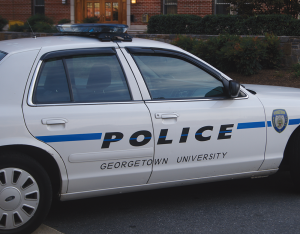
New technology has helped GUPD catch six suspects this year, out of 34 total incidents reported since Aug. 23.
The Georgetown University Police Department caught six suspects this month using security cameras and LiveSafe, the new mobile application that allows students to send anonymous tips and emergency calls.
According to the GUPD blotter records, there have been 34 incidents of theft or burglary on campus since Aug. 23.
Burglars in the Intercultural Center, Alumni Square and at bike racks outside of Lauinger Library were caught on the closed circuit television security system, while GUPD caught a flasher through the use of LiveSafe, which was rolled out earlier this fall.
“The CCTV system is very good,” Chief of Police Jay Gruber said. “It’s not often it actively captures somebody in the act, when they’re actually doing the crime, but forensically speaking, when we go back and review the video, we see images of the suspects.”
Gruber said that GUPD often utilized the CCTVs and that they have proven to be very effective, especially in the recent bike theft.
“It happens more often than you think,” Gruber said. “We reviewed the video and we saw the suspect who took the bike. … Our communications center personnel were doing virtual patrols, or taking control of the cameras and looking around, and the very next day one of the dispatchers saw the suspect at the Lauinger bike rack. We sent officers up there and we placed him under arrest.”
Since the start of the semester, there have been 34 cases of theft and burglary. Only one of those cases is closed. There have been no violent crimes reported by GUPD this semester.
The apprehended suspects for the burglaries in Alumni Square and the Lauinger bike rack were members of the Georgetown community.
Gruber said that the CCTVs are only in public spaces, preventing infringement on student privacy within dorm halls.
“All the cameras are in public spaces,” Gruber said. “They’re in places where people shouldn’t have an expectation of privacy. We don’t have them in spaces that would be considered private.”
About three weeks ago, GUPD officers arrested a subject reported with LiveSafe. According to Gruber, a female student was studying near the Einstein’s Bagels kiosk inside Regents Hall when a man approached her and asked to use the power socket by her table.
“When she looked up, this individual had his pants down around his ankles, exposing himself to her,” Gruber said. “She felt uncomfortable making a phone call, so she used the LiveSafe app to text the police communications center with what happened and a description of the suspect.”
Once officers learned of the information from LiveSafe, they immediately dispatched to Regents Hall, identified the suspect and arrested him.
“It’s a real success story,” Gruber said. “We may not have gotten that information quickly, the victim may have felt uncomfortable making a phone call while the guy was there, so the app worked just like we hoped it would.”
Livesafe founder Shy Pahlevani said that the app has contributed to many arrests on college campuses because it provides students with a familiar and user-friendly interface.
“It’s very common [to catch criminals with LiveSafe],” Pahlevani said. “When you give students a medium that they feel comfortable communicating through, messaging through an app, they’re much more likely to be sharing information. We get a high level of tips that come in that lead to arrests.”
LiveSafe is currently utilized in 18 states, but Pahlevani said he hopes to expand to enhance safety in campuses all over the country.
“I’d love to be able to share this with as many campuses as possible,” Pahlevani said. “With the amount of sexual assault incidences going on, we get a lot of tips about that. We’ve seen a lot of adoption of our technology across the country. We’d like to get it to more campuses across the country so that people have more access to tools. Obviously these things can’t stop tragedies, but they can definitely be preventative and they can assist in ways that student networks couldn’t before.”
Alex Feltes (COL ’18) said that the enhancement of technological safety feature on campus makes him feel more secure.
“I feel like having cameras around campus, having closed circuit TV, makes us a safer campus because it helps prevent burglaries and things that could be harmful to both facilities on campus and students as well,” Feltes said.





















haley • Oct 1, 2014 at 12:57 am
Is the bias-related incident not considered a violent crime?
DoPS4Life • Sep 30, 2014 at 1:54 pm
How many of the “suspects” were distributing conforms?